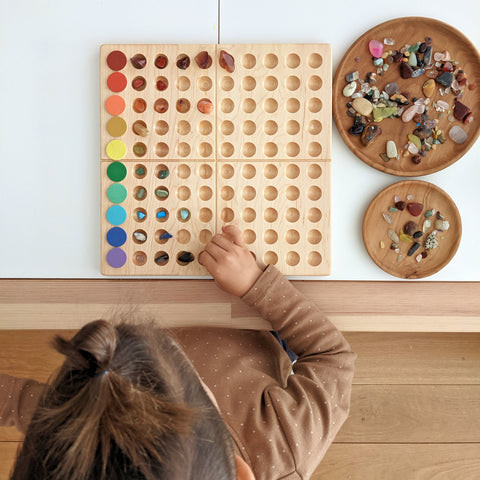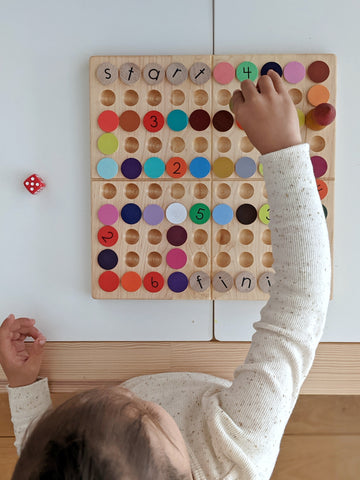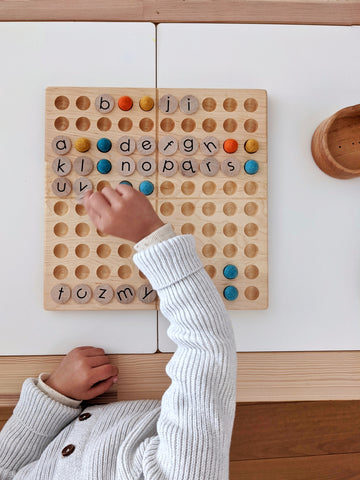
We absolutely love our Hundreds board from Treasures From Jennifer. It is made from walnut or maple hardwood and finished with shellac on top and flaxseed oil on the sides and bottom. It’s a big board, measuring 30cm square with one hundred dimples ready to be filled.
The Hundreds Board is a key Montessori Mathematics material, which helps children make the leap from the recognition of numbers, to understanding how they belong in a sequence.
But what can you do with it?
We have listed our ten favourite ways to use the board at home and school.
1. Fill the board with numbers
Filling the board with number coins must be the most obvious one. Children using the board this way need to have a clear understanding of numbers one to ten. This is usually around three or four years of age, depending on how quickly the child has grasped the concept of counting.

For younger children it helps to divide the numbers in smaller groups. A bowl for each row makes it less overwhelming. I recommend using the number words when ordering the numbers: "2 and 7 says twenty-seven. That is one more than 26"

2. Make a graph
For this activity you divide the hundreds board on 3 or more sections. You need a topic for your graph which can really be anything! In our case we investigated a heavy-vehicle magazine which we received at a fair.
I created three temporary coins by cutting out pictures of a digger, bulldozer and ‘other’ and used blue tac to stick them to the coin.
We then went through the pages of the magazine. We placed one ball in the right section for each vehicle we found. Once we finished, we had a conversation about our findings. Which vehicle did we see the most, which one the least? Why would that be?

3. Colour sorting with gemstones
This set up is a wonderful mindfulness activity. I set up the board with the gradient colour coins in the first column and gave Benji a bowl full of the gemstones. He sifted through the stones to find a perfect match. It’s a wonderful calm way to wind down during busy days.

4. Create a board game
Benji absolutely adores boardgames, and we often create our own. This game was a very simple set up with very easy rules. We created a path over the hundreds board using the coloured coins. Then we replaced a few of them with coloured number coins. Red shaded ones mean go back the number of steps mentioned on the coin, and the green ones mean go ahead. There was also one white coin, which allowed you to take ‘a shortcut’.

5. Make a drawing
Another lovely calm activity is to ‘draw’ with the wool balls. You can create lovely scenes filled with houses, trees and flowers. A butterfly, a kite, what about a rocket… the sky is the limit! For younger children you can focus on shapes. Benji loved making ‘big big rectangles’ for the longest of times. Older children can also try and create the first letter of their name, or use a combination of coloured coins and balls to create more elaborate creations.

6. Play a variation of dots and boxes
I remember this game from when I was a child, I played it for hours on end, with whoever I could find. For the original version you need dotted paper and pens.
Two players take turns to join two dots. If a player completes the fourth side of a box they initial that box and get a point. The winner is the one with the most points when all the boxes have been finished. With this version instead of drawing the boxes, you place a wool ball anywhere on the hundreds board. The aim is to get 4 balls in a square to get a point. There is lots of strategy involved in this game as you need to focus on building your own squares, but also block your opponent!
7. Find the missing number
This is a simple set up focusing on number recognition and sequence. Ask the child to fill the full board with number coins. Then replace some of the numbers with wool balls and place the numbers in a bowl. Younger children might like to just complete the board with no further challenge (Benji sure does – he can do this for an extended period of time, and doesn’t need a game element added to it).
With older children you can play the yes/no game. You hold a number coin in your hands, they have to guess which one by asking questions. ‘Is it higher than 20, is it an even number, does it have a seven in it’ etc. Who can fill the board with the least number of questions?

8. Play guess the word
This is a variation of hangman. On the top row you place wool balls or colour coins for each letter of the word you want to be guessed (we chose orange for consonants and yellow for vowels).
A few rows below you place all the letters of the alphabet. The bottom row is filled with blue balls, these are the number of turns you have.
Player one sets up the board, and player 2 will guess the letters in the word. Each correct letter means that the letter will replace a ball on the top row. If the letter is not in the word the letter is swapped with a blue ball.
If Player 2 guesses the word he/she wins. If the player runs out of turns (blue balls) the other player gets a point.
Note – it makes it easier if you only use words that uses each letter only once, otherwise you need to keep duplicates nearby.


9. Find the pom poms in rice
Sensory play never gets boring! This set up takes about a minute and is one of our go to activities. Add the pom poms to a tray of rice, mix it together, place the empty board and a pair of tweezers next to it and you’re done! It’s a great one for fine motor skills, and perseverance! Older children might like to try to see who can fill a row/the board the quickest. Or even try to use the other hand for more of a challenge!
10. Create patterns
It seems so simple, but pattern recognition is such an important skill to develop. Australian researchers, Papic, Mulligan and Mitchelmore (2011) have found that teaching pattern awareness to pre-schoolers, has a positive effects on their later number understanding. It was found that young children's ability to spot mathematical patterns can predict later mathematical achievement, more than other abilities such as counting (http://nrich.maths.org/9968). The coloured wool balls are perfect for this development!
We started with simple patterns such as red/blue/red/blue. Now Benji can confidently repeat patterns such as red/blue/blue/pink/red…
The great thing about it is that you can make it as easy or complicated as you like.




